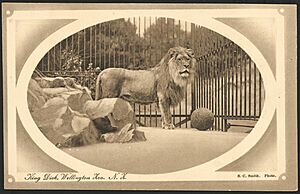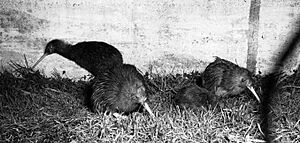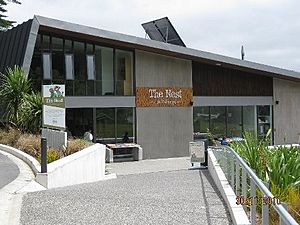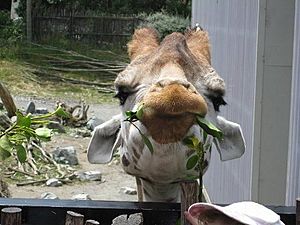Wellington Zoo facts for kids
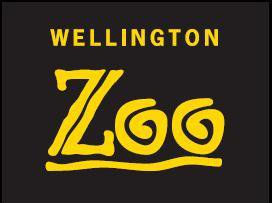 |
|
| Date opened | 1906 |
|---|---|
| Location | 200 Daniell Street, Newtown, Wellington, New Zealand |
| Land area | 13 ha (32 acres) |
| Coordinates | 41°19′21″S 174°47′06″E / 41.3225°S 174.7850°E |
| No. of animals | 500+ |
| No. of species | ≈80 |
| Annual visitors | 261,943 |
| Memberships | ZAA |
Te Nukuao Wellington Zoo (Māori: Te Nukuao Tūroa o Te Whanganui a Tara) is a 13-hectare zoo located in the green hills of Wellington, New Zealand. It is home to more than 500 animals from around 80 different species. The zoo is a special place where people can learn about animals and how to protect them.
Contents
The Story of Wellington Zoo
Wellington Zoo has a long and exciting history. It first opened way back in 1906. The whole thing started when a circus gave a young lion to New Zealand's prime minister, Richard Seddon. This lion was named "King Dick," and he became the zoo's very first animal!
Over the years, the zoo grew bigger and better. For a long time, it was run by the Wellington City Council. Since 2003, it has been managed by a charitable trust that works to make the zoo a great place for both animals and visitors.
Famous Animals and Events
The zoo has been home to many amazing animals. In the 1960s, a family of chimpanzees lived there. The zoo even used to host "chimpanzee tea parties," but this was stopped to give the chimps a more natural life.
Sometimes, unexpected things happened. In 1967, two tigers named Napoleon and Josephine escaped from their enclosure. They were found in a nearby neighborhood. Sadly, the tigers were a danger to the public and had to be put down, which made many people very upset.
Over the decades, the zoo welcomed new species.
- Sumatran Tigers: The first Sumatran tigers arrived in the 1990s, and several cubs have been born at the zoo since then.
- Malayan Sun Bears: Two sun bears arrived from San Diego Zoo in 1992. The zoo was the first in the Australasia region to successfully breed a sun bear.
- Giraffes: The zoo has had a family of giraffes for many years. In 2023, a baby giraffe named Nia was born, the first at the zoo in 20 years!
One of the zoo's most famous residents was Tahi, a one-legged brown kiwi who lived at the zoo for 15 years. In 2023, the zoo also welcomed two snow leopard sisters, Asha and Manju, who live in a special new habitat.
In 2024, the zoo's name was officially updated to 'Te Nukuao Tūroa o Te Whanganui a Tara Wellington Zoo Trust' to honor New Zealand's bi-cultural heritage. It is often shortened to Te Nukuao Wellington Zoo.
Helping Animals and the Planet
Wellington Zoo does more than just care for the animals inside its gates. It is dedicated to conservation, which means protecting animals and their natural homes all over the world.
The zoo is part of international breeding programs. These programs help make sure that animal species, especially endangered ones, can survive for a long time. They work with other zoos to keep animal populations healthy and genetically diverse.
The Nest Animal Hospital
The zoo has its own animal hospital called The Nest – Te Kōhanga. Here, veterinarians care for sick or injured wildlife from all over the Wellington region. The public can even watch the vets at work through a special viewing window and listen as they explain what they are doing. The Nest has helped thousands of native animals get better and return to the wild.
Community Projects
Wellington Zoo also works on projects in the local community.
- Places for Penguins: This project helps protect the nesting areas of little blue penguins along the Wellington coast.
- Kererū Discovery: The zoo works with other organizations to make Wellington a safer city for the native wood pigeon, the kererū.
- Skink Recovery: The zoo is helping to save the rare Whitaker's skink by breeding them and protecting the few that are left.
Visiting the Zoo
When you visit Wellington Zoo, there are many ways to learn and have fun. Zookeepers give talks every day about different animals, sharing cool facts about their behaviors and diets.
One of the most popular areas is Meet the Locals He Tuku Aroa. This exhibit takes you on a journey through New Zealand's own wildlife, from the sea to the mountains. You can see native birds and animals and learn about the efforts to protect them. It even includes a farm area where you can see kunekune pigs and other farm animals.
Animal Incidents
Working with wild animals always has risks, and zoos must be very careful. In 2006, a zookeeper was injured by two lions when a gate was accidentally left unlocked. Thankfully, other keepers acted quickly, and he was not seriously hurt.
In 2018, a man broke into the zoo to try and take a squirrel monkey. He was not successful, and the monkeys fought back. The man was injured, and some of the monkeys were very scared and stressed by the event. The zoo improved its security after this incident to keep the animals safe.
Amphibians
- Aquatic
Birds
|
|
|
|
Fish
Insects
|
|
Mammals
|
|
|
Reptiles
|
|
Spiders
- Chilean rose tarantulas
- Costa-rican zebra tarantulas
- Goliath birdeater spiders
- King baboon spiders
- Mexican redknee tarantulas
- Peruvian pinktoe tarantulas
Images for kids
See also
 In Spanish: Zoológico de Wellington para niños
In Spanish: Zoológico de Wellington para niños


